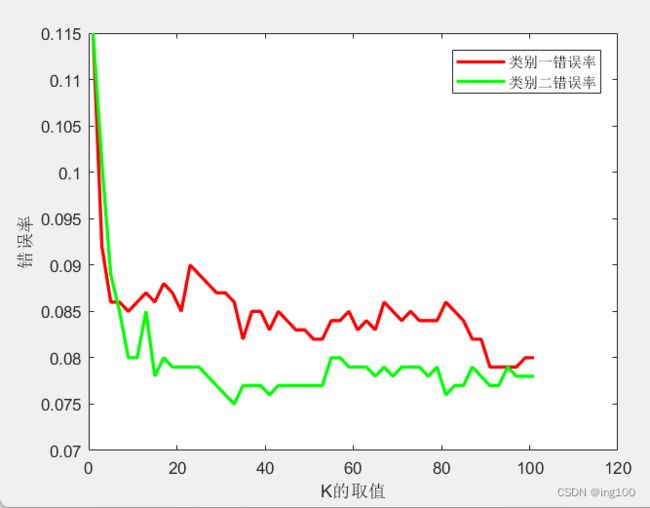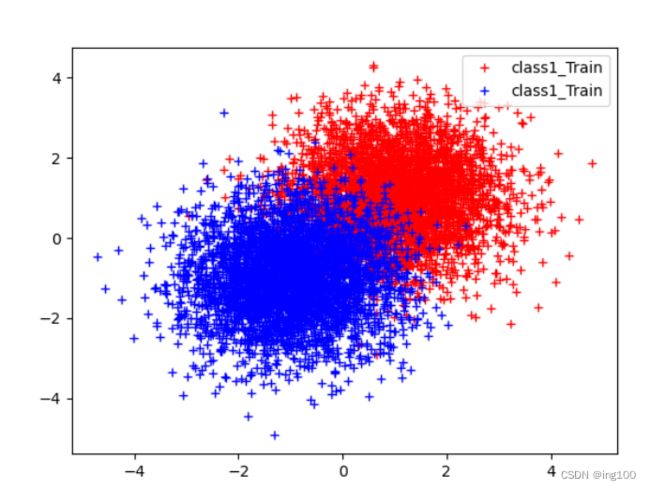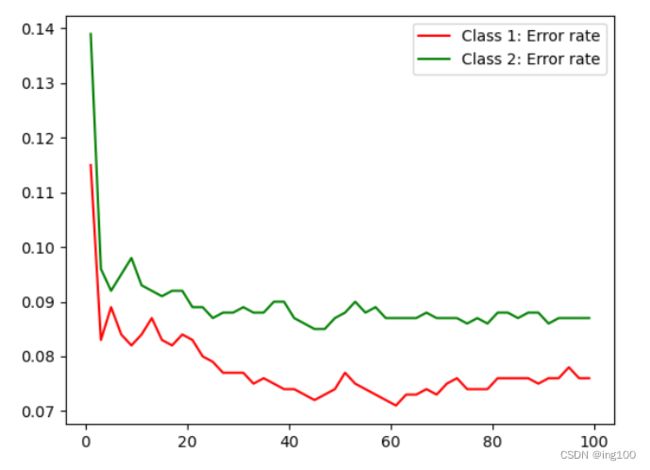K-近邻实现(K_Nearest_Neighbor)
目录
1、引言
2、K近邻法
2.1 Matlab实现
主函数
Loss函数
附上效果图
2.2、Python实现
2.3、C++实现
main函数
Loss函数
1、引言
本专栏会编程实现机器学习的一些经典算法并且使用三种不同语言(Matlab,python,c++)。本文只展示了部分代码,本专栏全部代码可以通过Github下载,这里里简述一下为什么是这三种语言吧,
首先是Matlab:这是大多数理工科学生都会用到的一个软件,仿真与分析计算的黑科技,从2022年开始matlab不断更新有关AI的工具包个人猜测以后会成为很多本科生和研究生的研究AI的工具
然后是python:目前最流行的AI以及数据分析的语言,其语法与matlab及其类似,外部库非常丰富,本文主要使用pytorch以及numpy这两个库进行实现
最后是C++:目前很多python有关深度学习的库都有C++的版本,比如pytotch->libtorch numpy->numcpp opencv-python->opencv等等。因为python的底层就是用C或者C++编写的所以C++的运行速度会比python快很多,个人觉得一个项目最后都最好使用C++落地,而专栏主要使用libtorch以及numcpp进行实现。
2、K近邻法
正题开始,本专栏的第一个算法就是K近邻法。
在介绍之前先说一下最近邻法:常用于分类,以二分类为例,给定一些训练样本分为A类和B类以及一个测试样本然后找到测试样本离训练样本最近的一个点,查看这个点属于什么类别就作为测试样本的类别。
最近邻法就是K=1时的K近邻法,所以K近邻就是找到K个(K都是人为定义的一个数)距离训练样本最近的点,判断在K个点中哪种类别的数量更多。为了防止在K个点中A类与B类的数量一样多,所以K的取值一般为奇数(1,3,5等等)
之后的代码都会完成这几个任务(三种代码逻辑完全一致)
(1)使用随机函数生成10000个随机样本,共两类,每类5000个,其中每类中4000个为训练集,1000个为测试集。作为后续程序的数据基础。
(2)编写k近邻法程序,实现对两类共2000个测试样本的近邻法判别。
(3)统计1、3、5、7.....、101时的测试错误率,绘制错误率曲线。
2.1 Matlab实现
主函数
clc;clear all;close all % 清理
%% 制定训练集
% 使用randn函数产生均值为0,方差σ^2 = 1,标准差σ=1的正态分布的随机矩阵,2000个数据,分两类。
X = [randn(5000,2)+ones(5000,2);randn(5000,2)-ones(5000,2)];
X(1:5000,3)=1;
X(5001:10000,3)=2;
% 划分训练集以及测试集
% 对于类别一 1-4000为训练集 4001-5000为测试集
% 对于类别二 5001-9000为训练集 9001-10000为测试集
class1_train = X(1:4000,:);
class1_test = X(4001:5000,:);
class2_train = X(5001:9000,:);
class2_test = X(9001:10000,:);
%% 绘图
figure
plot(class1_train(:,1),class1_train(:,2),'r*'); hold on;
plot(class2_train(:,1),class2_train(:,2),'b*');
grid on;
legend({'class2train','class2test'},'Location','northwest')
%% 存储
%save ('NN_2000.mat','X');
%frame = getframe(fig); % 获取frame
%img = frame2im(frame); % 将frame变换成imwrite函数可以识别的格式
%imwrite(img,'a.png');
%% 开始运行K近邻 K从1到101步长为2
total_Kcorrect1 = [];
for i=1:2:101
[num_correct1] = Loss(class1_train,class2_train,class1_test,i);
total_Kcorrect1 = [total_Kcorrect1;num_correct1];
end
total_Kcorrect2 = [];
for j=1:2:101
[num_correct2] = Loss(class1_train,class2_train,class2_test,j);
total_Kcorrect2 = [total_Kcorrect2;num_correct2];
end
%% 统计结果
figure
x = linspace(1,101,51);
plot(x,1-total_Kcorrect1/1000,'r','LineWidth',2)
hold on
plot(x,1-total_Kcorrect2/1000,'g','LineWidth',2)
legend({'类别一错误率','类别二错误率'})Loss函数
function [correct_num] = Loss(class1,class2,test,k)
x = size(test,1); % test数据集有多少行
num1=0;
num2=0;
correct_num=0;
distance = [];
for i=1:x
% 开始计算单个测试数据与其它8000个训练集的距离
distance1 = sqrt( (class1(:,1)-test(i,1)).^2 + (class1(:,2)-test(i,2)).^2 );
%distance = [distance;distance1];
distance2 = sqrt( (class2(:,1)-test(i,1)).^2 + (class2(:,2)-test(i,2)).^2 );
distance = [distance1;distance2];
% 进行逆序排列取前k个
[~,index] = sortrows(distance);
for j=1:k
if index(j,1) < 4000
num1 = num1 +1;
elseif index(j,1) > 4000
num2 = num2 + 1;
end
end
if num1 > num2
if test(i,3) == 1
correct_num = correct_num + 1;
end
elseif num1 < num2
if test(i,3) == 2
correct_num = correct_num + 1;
end
end
num1 = 0;
num2 = 0;
end
end
附上效果图
2.2、Python实现
python实现会使用到深度学习框架pytorch因其可以使用GPU加速运算,若读者感兴趣也可以使用numpy实现(难度不高,pytorch对数组的操作numpy基本都有)
main函数
if __name__ == "__main__":
## 定义数据集
device = torch.device('cuda' if torch.cuda.is_available else 'cpu')
X1 = torch.randn(5000, 2) + torch.ones(5000, 2)
X2 = torch.randn(5000, 2) - torch.ones(5000, 2)
X = torch.cat((X1, X2), 0, ) # (10000,2)
label = torch.IntTensor(10000, 1)
label[:5000] = 1
label[5000:] = 2
Data_set = torch.cat((X, label), 1)
# Data_set = Data_set.cuda()
class1_train = Data_set[:4000, :]
# print(class1_train.device)
class1_test = Data_set[4000:5000, :]
class2_train = Data_set[5000:9000, :]
class2_test = Data_set[9000:, :]
## 绘制数据集
plt.plot(class1_train[:, 0], class1_train[:, 1], 'r+', label="class1_Train")
plt.plot(class2_train[:, 0], class2_train[:, 1], 'b+', label="class1_Train")
plt.legend(loc='upper right')
plt.show()
## 开始训练
total_Kcorrect1 = []
for num_k in range(1, 11, 2):
num_correct = Loss(class1_train, class2_train, class1_test, num_k)
total_Kcorrect1.append(num_correct)
total_Kcorrect2 = []
for num_k in range(1, 11, 2):
num_correct = Loss(class1_train, class2_train, class2_test, num_k)
total_Kcorrect2.append(num_correct)
total_Kcorrect2 = list(map(lambda x : float(1-x/1000), total_Kcorrect2))
total_Kcorrect1 = list(map(lambda x : float(1-x/1000), total_Kcorrect1))
plt.figure()
x = range(1, 11, 2)
plt.plot(x, total_Kcorrect1[:], 'r-', label='Class 1: Error rate')
plt.plot(x, total_Kcorrect2[:], 'g-', label='Class 2: Error rate')
plt.legend()
plt.show()Loss函数
def Loss(class1,class2,test,k):
x = test.shape
correct_num = 0
distance = torch.Tensor([]).cuda()
# distance = torch.Tensor([])
print(distance.device)
for i in range(0, x[0]):
num1 = 0
num2 = 0
distance1 = torch.sqrt( torch.square(class1[:, 0]-test[i, 0]) + torch.square(class1[:, 1]-test[i, 1]) )
distance1.to(device)
distance2 = torch.sqrt( torch.square(class2[:, 0]-test[i, 0]) + torch.square(class2[:, 1]-test[i, 1]) )
distance2.to(device)
distance = torch.cat((distance1,distance2), 0)
_, index = torch.sort(distance, 0)
for j in range(0, k):
if index[j] <= 4000:
num1 = num1 + 1
elif index[j] > 4000:
num2 = num2 + 1
if num1 > num2 and test[i, 2] == 1:
correct_num = correct_num + 1
elif num1 < num2 and test[i, 2] == 2:
correct_num = correct_num + 1
return correct_num效果展示
2.3、C++实现
C++会使用到使Libtorch库(pytorch的C++版本),同样若读者感兴趣也可以使用numcpp实现,安装方法这里不多介绍以下为代码
main函数
void main()
{
vector total_Kcorrect1;
vector total_Kcorrect2;
int num_correct = 0;
torch::Tensor X1 = torch::randn({ 5000,2 }) + torch::ones({ 5000,2 });
torch::Tensor X2 = torch::randn({ 5000,2 }) - torch::ones({ 5000,2 });
torch::Tensor X = torch::cat({ X1, X2 }, 0);
torch::Tensor label1 = torch::full({ 5000,1 },1);
torch::Tensor label2 = torch::full({ 5000,1 }, 2);
torch::Tensor label = torch::cat({ label1, label2 }, 0);
torch::Tensor data_set = torch::cat({ X,label }, 1).to(device_type); // GPU CUDA0
// cout << data_set.device() << endl;
// 划分训练集以及测试集
auto class1_train = data_set.narrow(0, 0, 4000);
auto class1_test = data_set.narrow(0, 4000, 1000);
auto class2_train = data_set.narrow(0, 5000, 4000);
auto class2_test = data_set.narrow(0, 9000, 1000);
for (int m1 = 1; m1 <= 101; m1 = m1 + 2)
{
num_correct = Loss(class1_train, class2_train, class1_test, m1);
total_Kcorrect1.push_back(num_correct);
}
for (int m2 = 0; m2 < 101; m2 = m2 + 2)
{
num_correct = Loss(class1_train, class2_train, class1_test, m2);
total_Kcorrect2.push_back(num_correct);
}
for (int k = 0; k < total_Kcorrect1.size(); k++)
{
cout << total_Kcorrect1[k] << " ";
}
} Loss函数
long Loss(torch::Tensor class1, torch::Tensor class2, torch::Tensor test,int k)
{
c10::IntArrayRef tsize = test.sizes();
int num1 = 0;
int num2 = 0;
int correct_num = 0;
auto distance = torch::tensor({ }).to(device_type);
cout << distance.device() << endl;
for (long i = 0; i < tsize[0]; i++)
{
auto distance1 = torch::sqrt(torch::square(class1.narrow(1, 0, 1) - test[i][0]) + torch::square(class1.narrow(1, 1, 1) - test[i][1])).to(device_type);
auto distance2 = torch::sqrt(torch::square(class2.narrow(1, 0, 1) - test[i][0]) + torch::square(class2.narrow(1, 1, 1) - test[i][1])).to(device_type);
auto distance = torch::cat({ distance1, distance2 }, 0);
tuple sort_ret = torch::sort(distance, 0, 0); // {8000,1}
//cout << distance << endl;
for (int j = 0; j < k; j++)
{
int a = (get<1>(sort_ret)[j][0]).item();
if (a <= 4000)
{
num1 += 1;
}
else if (a > 4000)
{
num2 += 1;
}
}
if (num1 > num2 && test[i][2].item() == 1)
{
correct_num += 1;
}
else if (num1 < num2 && test[i][2].item() == 2)
{
correct_num += 1;
}
num1 = 0;
num2 = 0;
}
return correct_num;
}


